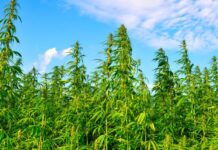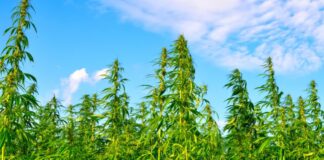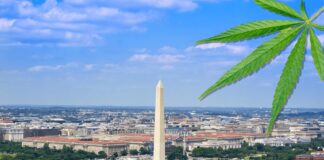
More than 3.8 million people in the United States misuse opioids, and according to the U.S. Department of Health and Human services, 130 people die from opioid-related drug overdoses each day. In this context, the use of medicinal cannabis as an opioid alternative is gaining momentum, with many touting it as a safe source of pain relief.
One clinical survey published January 2019 in the Harm Reduction Journal found that patients chose to substitute cannabis for opioids based on the beliefs that cannabis is a safer alternative that prescription drugs (expressed by 51.2 percent of participants), and that it has fewer side effects (reported by 39.7 percent of participants).
Two 2018 studies have explored the effects of cannabis use on opioid dose reduction. Their results suggest that the interaction of cannabis and opioids merits deeper analysis. The use of cannabis for pain relief, particularly chronic pain relief, is more complex than simply subbing it in place of opioids.
41% of cancer and rheumatological patients who began using medical marijuana were able to decrease their dependence on opioids. Click To Tweet
In the first study, published in the Journal of Clinical Oncology in December 2018, researchers found that 41 percent of cancer and rheumatological patients who began using medical marijuana were able to decrease their dependence on opioids to some degree. Sixty-three percent of patients reduced their use of opioids by 25 percent, and 37 percent reduced their opioid dose by 26 percent or more.
Among the cancer patients, 80 percent agreed their experience of pain lessened, and 75 percent of rheumatological patients also reported experiencing a reduction in pain. Patients who had depression managed to reduce their dependence on opioids by 32 percent.
“We did have a few patients who stopped taking opioids completely, but the numbers would be too small to be statistically significant. We need a much larger study to look into that,” said Dr. Ajaz Bulbul, one of the lead researchers on the study.
Within the cohort of 133 patients, researchers administered non-steroidal anti-inflammatory drugs in addition to medicinal cannabis to some participants. Interestingly, the anti-inflammatory drugs used in conjunction with medicinal marijuana further enhanced results: 67 percent of those who received the additional anti-inflammatory medication noted an improved pain score, compared with 33 percent who took medicinal cannabis without anti-inflammatories and noted that their pain improved.
“Anti-inflammatory use clearly reduced the dosage of opioids and helped medicinal cannabis achieve a higher reduction of pain,” Bulbul said. “This likely has to do with the differing mechanisms of actions of each. Anti-inflammatories target the inflammatory response by targeting prostaglandins, whereas we think medicinal cannabis targets multiple receptor targets like opioid receptors.”
Bulbul points out that one of the limitations of the study was that the negative side effects of medical marijuana use were not methodically examined. The study did not investigate the temporary or long-term effects of medical cannabis, such as potential toxicity, which would be vital to research before recommending it as a possible intervention.
“I have had patients who have not tolerated medical cannabis but have had temporary symptoms that subsided after stopping it. Most patients, in my opinion, benefit to some extent,” he said.
Another 2018 study published in the Journal of Addiction Medicine explored the use of cannabis and opioids together for chronic pain management, compared with patients using opioids alone. The study included 450 participants, and the results suggested that the combination of cannabis and opioids was associated with increased symptoms of anxiety and depression.
Those who used both cannabis and opioids also reported higher use of tobacco, alcohol, cocaine, and sedatives. The experience of pain, however, was not elevated. The study’s researchers emphasize that the co-use of substances is generally associated with poorer overall outcomes than the use of a single substance for pain management.
One limitation of the research was that it examined poly-substance users with chronic pain, who may not be reflective of those with general pain.
“While their pain is important to treat, it’s likely that their underlying neurologic system and their psychological makeup are different to that of other pain patients,” said Dr. Jordan Tishler, president and CEO of the Association of Cannabis Specialists.
The findings of these studies underline the complexity of using multiple substances for the treatment of pain, and the need for more comprehensive research to better understand how cannabis works in concert with opioids for pain treatment.
While the results of the studies are not necessarily conflicting, they do reveal that present knowledge around the interaction of cannabis and opioids is far from conclusive.
Reflecting on his research, Bulbul pointed out that dosing represents one of the most significant challenges for doctors currently prescribing cannabis to reduce opioid dependency.
“If someone smokes or consumes a marijuana cookie, what target levels are we achieving? How often should a patient use cannabis, what strains, hybrids or pure forms? Most of us physicians are not well-versed with it. We don’t prescribe a dose,” he said.
While many members of the medical community are hopeful that medicinal cannabis holds the key to healing the opioid epidemic, there is still an awareness that cannabis and opioids both have their own role to play in pain management. As Tishler notes, cannabis helps most patients reduce opioid intake, but does not eliminate their opioid use completely.
“For mild to moderate pain, cannabis can be an effective direct substitute for opioids. It is my impression that we should be using cannabis as second-line treatment of pain — after Tylenol and non-steroidal anti-inflammatories–but before opioids,” Tishler said. “For more significant pain, opioids may remain necessary, but the overall dose may be significantly less. Risk from opioids is directly dose-dependent, so that any decrement is valuable.”
Both Tishler and Bulbul highlight that the benefits they have witnessed in prescribing cannabis to pain patients are encouraging, citing improved quality of life and improved pain reporting, in addition to reduced opioid use.
“Sometimes the answers don’t lie in complicated statistical equations of studies, but in judging where society and patient advocacy is leading us,” Bulbul said. “We are now more open as a medical fraternity and society to demystifying marijuana. It may not be a cure-all, but it may help, and studies like these are just a starting point.”











